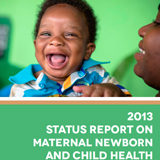
Background: The Continental Policy Framework on Sexual and Reproductive Health and Rights and the Maputo Plan of Action for its operationalization are key tools guiding Africa’s efforts to achieve the United Nation’s Millennium Development Goals 4 and 5 by 2015.1 The Campaign on Accelerated Reduction of Maternal, Newborn, and Child Mortality in Africa serves as a critical advocacy platform for improvement of maternal, newborn and child health. Launched by 40 of the 54 African Union Member States, this campaign has motivated national ownership of significant maternal, newborn, and child health initiatives.
In 2010, after reviewing implementation of the Maputo Plan of Action, the 15th Session of the Ordinary African Union Assembly instructed the African Union Commission to report annually on the status of maternal, newborn, and child health in Africa until 2015.2 In response, the African Union Commission collaborated with its partners to develop and submit the First Annual Report on the
In January of 2013, at the 20th Ordinary African Union Assembly, the African Union heads of state and government instructed the Conference of African Union Ministers of Health to review the maternal, newborn, and child health situation in Africa and report back to the Assembly. The Heads of State and Government also asked the ministers to use their report to underscore the outcomes of the event, “Reinforcing the Campaign on Accelerated Reduction of Maternal Mortality in Africa,” where heads of state and government had reaffirmed their commitment to promoting the health of women and
Child health: Globally, over 20,000 children under age five die each day and the majority of these deaths are caused by preventable illnesses. The four major killers of children under five are pneumonia (18 percent), diarrheal diseases (15 percent), preterm birth complications (12 percent), and birth asphyxia (9 percent). In Africa south of the Sahara, malaria is still a major killer, causing about 16 percent of deaths among children under ive.3 Additionally, under-nutrition is an underlying cause in more than a third of deaths among African children under five.
All countries are aiming to achieve Millennium Development Goal 4: reduction of child mortality by two-thirds. In the last 22 years, African countries south of the Sahara have reduced their child mortality by 39 percent and have doubled their annual rate of reduction from 1.5 percent to 3.1 percent. Among the 44 countries for which Millennium Development Goal 4 data are available:
• 2 have achieved the goal (Egypt and Liberia),
• 4 countries are on track to achieve the goal,
• 26 countries have made insufficient progress toward the goal, and
• 12 have made no progress toward the goal.4